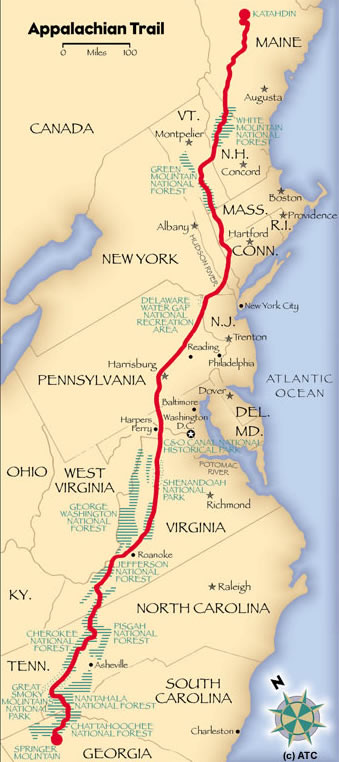

History
The trail was conceived by Benton MacKaye, a forester who wrote his original plan shortly after the death of his wife in 1921. MacKaye's idea detailed a grand trail that would connect a series of farms and wilderness work/study camps for city-dwellers. In 1922, at the suggestion of Major William A. Welch, director of the Palisades Interstate Park Commission, his idea was publicized by Raymond H. Torrey with a story in the New York Evening Post under a full-page banner headline reading "A Great Trail from Maine to Georgia!" The idea was quickly adopted by the new Palisades Interstate Park Trail Conference as their main project.
On October 7, 1923, the first section of the trail, from Bear Mountain west through Harriman State Park to Arden, New York, was opened. MacKaye then called for a two-day Appalachian Trail conference to be held in March 1925 in Washington, D.C. This resulted in the formation of the Appalachian Trail Conference (now called the Appalachian Trail Conservancy).
A retired judge named Arthur Perkins and his younger associate Myron Avery took up the cause. In 1929, Perkins, who was also a member of the Connecticut Forest and Park Association and its Blue Blazed Trails committee, found Ned Anderson, a farmer in Sherman, Connecticut, who took on the task of mapping and blazing the Connecticut leg of the trail (1929–1933). It ran from Dog Tail Corners in Webatuck, New York, which borders Kent, Connecticut, at Ashley Falls, 50 miles (80 km) through the northwest corner of the state, up to Bear Mountain at the Massachusetts border. (A portion of the Connecticut trail has since been rerouted [1979–83] to be more scenic, adhering less to highways and more to wilderness, and includes a Ned K. Anderson Memorial Bridge.)
Anderson's efforts helped spark renewed interest in the trail, and Avery (leading the charge since Perkins’ death in 1932) was able to bring other states on board. Upon taking over the ATC, Avery adopted the more practical goal of building a simple hiking trail. He and MacKaye clashed over the ATC's response to a major commercial development along the trail's path; MacKaye left the organization, while Avery was willing to simply reroute the trail. Avery reigned as Chairman of the ATC from 1932 to 1952 (he died that same year).
Journal describing two days and a night of a trail hiker.
The hiker meets a college professor who invites him to share his slides the next autumn. With meager supplies for the night he goes to sleep without supper or fire. The hiker writes, "Had no supper since all the eatable I had was half a pd of bacon the tower man at Peaks of Otter gave me. Otherwise I have baking powder, salt, and some baking chocolate but no sugar to make it palatable...
Rose early after a fairly good night without fire, and followed trail. About seven stopped and fried bacon, which was delicious. Now will proceed force march to nearest store. "
Avery became the first to walk the trail end-to-end, though not as a thru-hike, in 1936. In August 1937, the trail was completed to Sugarloaf Mountain in Maine, and the ATC shifted its focus toward protecting the trail lands and mapping the trail for hikers.
In 1948, Earl Shaffer of York, Pennsylvania, brought a great deal of attention to the project by completing the first documented thru-hike. Later Shaffer also completed the first north-to-south thru-hike, making him the first to do so in each direction. In 1998 Mr. Shaffer, nearly 80 years old, again hiked the entirety of the trail, making him the oldest person ever to complete a thru-hike.
In 1994, a story appeared in the Appalachian Trailway News describing a 121-day Maine to Georgia thru-hike in 1936 by six Boy Scouts from the Bronx. Although the story has been accepted by some members of ALDHA, a great deal of doubt has also been expressed and this earlier thru-hike has never been verified. Shaffer's 1948 journey is still generally recognized as the first A.T. thru-hike.
In the 1960s, the ATC made progress toward protecting the trail from development, thanks to efforts of politicians and officials. The National Trails System Act of 1968 designated the Pacific Crest Trail and Appalachian Trail as the first national scenic trails and paved the way for a series of National Scenic Trails within the National Park and National Forest systems. Trail volunteers worked with the National Park Service to map a permanent route for the trail, and by 1971 a permanent route had been marked (though minor changes continue to this day). By the close of the 20th century, the Park Service had completed the purchase of all but a few miles of the trail's span.

